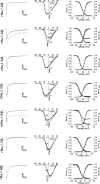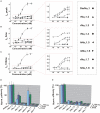Phyla- and Subtype-Selectivity of CgNa, a Na Channel Toxin from the Venom of the Giant Caribbean Sea Anemone Condylactis Gigantea
- PMID: 21833172
- PMCID: PMC3153007
- DOI: 10.3389/fphar.2010.00133
Phyla- and Subtype-Selectivity of CgNa, a Na Channel Toxin from the Venom of the Giant Caribbean Sea Anemone Condylactis Gigantea
Abstract
Because of their prominent role in electro-excitability, voltage-gated sodium (Na(V)) channels have become the foremost important target of animal toxins. These toxins have developed the ability to discriminate between closely related Na(V) subtypes, making them powerful tools to study Na(V) channel function and structure. CgNa is a 47-amino acid residue type I toxin isolated from the venom of the Giant Caribbean Sea Anemone Condylactis gigantea. Previous studies showed that this toxin slows the fast inactivation of tetrodotoxin-sensitive Na(V) currents in rat dorsal root ganglion neurons. To illuminate the underlying Na(V) subtype-selectivity pattern, we have assayed the effects of CgNa on a broad range of mammalian isoforms (Na(V)1.2-Na(V)1.8) expressed in Xenopus oocytes. This study demonstrates that CgNa selectively slows the fast inactivation of rNa(V)1.3/β(1), mNa(V)1.6/β(1) and, to a lesser extent, hNa(V)1.5/β(1), while the other mammalian isoforms remain unaffected. Importantly, CgNa was also examined on the insect sodium channel DmNa(V)1/tipE, revealing a clear phyla-selectivity in the efficacious actions of the toxin. CgNa strongly inhibits the inactivation of the insect Na(V) channel, resulting in a dramatic increase in peak current amplitude and complete removal of fast and steady-state inactivation. Together with the previously determined solution structure, the subtype-selective effects revealed in this study make of CgNa an interesting pharmacological probe to investigate the functional role of specific Na(V) channel subtypes. Moreover, further structural studies could provide important information on the molecular mechanism of Na(V) channel inactivation.
Keywords: inactivation; sea anemone; selectivity; sodium channel; subtype; toxin.
Figures




Similar articles
-
CgNa, a type I toxin from the giant Caribbean sea anemone Condylactis gigantea shows structural similarities to both type I and II toxins, as well as distinctive structural and functional properties(1).Biochem J. 2007 Aug 15;406(1):67-76. doi: 10.1042/BJ20070130. Biochem J. 2007. PMID: 17506725 Free PMC article.
-
A new toxin from the sea anemone Condylactis gigantea with effect on sodium channel inactivation.Toxicon. 2006 Aug;48(2):211-20. doi: 10.1016/j.toxicon.2006.05.001. Epub 2006 May 19. Toxicon. 2006. PMID: 16814340
-
Synthesis, solution structure, and phylum selectivity of a spider delta-toxin that slows inactivation of specific voltage-gated sodium channel subtypes.J Biol Chem. 2009 Sep 4;284(36):24568-82. doi: 10.1074/jbc.M109.030841. Epub 2009 Jul 10. J Biol Chem. 2009. PMID: 19592486 Free PMC article.
-
Actions of sea anemone type 1 neurotoxins on voltage-gated sodium channel isoforms.Toxicon. 2009 Dec 15;54(8):1102-11. doi: 10.1016/j.toxicon.2009.04.018. Epub 2009 Apr 23. Toxicon. 2009. PMID: 19393679 Review.
-
[Mechanism of action of neurotoxins acting on the inactivation of voltage-gated sodium channels].C R Seances Soc Biol Fil. 1998;192(3):409-36. C R Seances Soc Biol Fil. 1998. PMID: 9759381 Review. French.
Cited by
-
The Sea Anemone Neurotoxins Modulating Sodium Channels: An Insight at Structure and Functional Activity after Four Decades of Investigation.Toxins (Basel). 2022 Dec 21;15(1):8. doi: 10.3390/toxins15010008. Toxins (Basel). 2022. PMID: 36668828 Free PMC article. Review.
-
Interactions of Sea Anemone Toxins with Insect Sodium Channel-Insights from Electrophysiology and Molecular Docking Studies.Molecules. 2021 Feb 28;26(5):1302. doi: 10.3390/molecules26051302. Molecules. 2021. PMID: 33670972 Free PMC article.
-
The Invasive Anemone Condylactis sp. of the Coral Reef as a Source of Sulfur- and Nitrogen-Containing Metabolites and Cytotoxic 5,8-Epidioxy Steroids.Metabolites. 2023 Mar 7;13(3):392. doi: 10.3390/metabo13030392. Metabolites. 2023. PMID: 36984832 Free PMC article.
-
New Insights into the Type II Toxins from the Sea Anemone Heteractis crispa.Toxins (Basel). 2020 Jan 10;12(1):44. doi: 10.3390/toxins12010044. Toxins (Basel). 2020. PMID: 31936885 Free PMC article.
-
Functional coupling between sodium-activated potassium channels and voltage-dependent persistent sodium currents in cricket Kenyon cells.J Neurophysiol. 2015 Oct;114(4):2450-9. doi: 10.1152/jn.00087.2015. Epub 2015 Aug 12. J Neurophysiol. 2015. PMID: 26269549 Free PMC article.
References
-
- Armstrong C. M. (1981). Sodium channels and gating currents. Physiol. Rev. 61, 644–683 - PubMed
-
- Black J. A., Liu S., Tanaka M., Cummins T. R., Waxman S. G. (2004). Changes in the expression of tetrodotoxin-sensitive sodium channels within dorsal root ganglia neurons in inflammatory pain. Pain 108, 237–247 - PubMed
LinkOut - more resources
Full Text Sources

